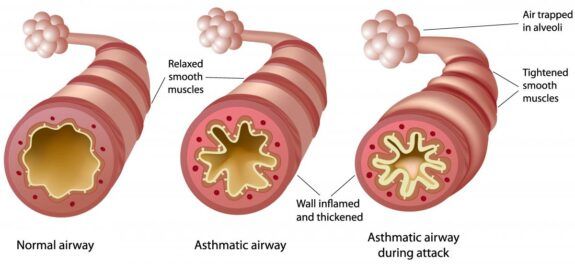For healthcare professionals
How to reduce the carbon footprint of inhalers: We have two guides, one for adults and another for children and young people. These set out key priorities and principles, and have a handy table of inhalers by carbon footprint category.
Visual aid for optimising asthma reviews: One-page visual aid to support a person-centred asthma review. Ensuring patients get the right medicine (preventer) to get the right place (airways). It has hyperlinks to various resources.

A larger version of this diagram can be found here. It can help to explain that the underlying problem in asthma is airway lining inflammation and hence the importance of inhaled corticosteroid as the main treatment for asthma.
Caring for Patients who Use Inhalers: A overview of all medicines and inhalers in use in one table.
Obtaining Placebo inhaler devices: information on how to obtain placebo devices for demonstrating inhaler technique.
IT resources
Primary Care IT have developed free resources for EMIS and SystmOne. This includes searches, patient status alerts/red box alerts and an asthma review template. Remember to check your ‘junk’ folder for an email once requested. Support articles for the resources are available for EMIS and S1.
If you have access to Arden’s resources, they also have an asthma template and you can find their IIF searches in SystmOne through this support article.
Baseline Data (for practices in England)
The NHSE PCN Deep Dive Dashboard, offers practice and PCN level data on four indicators related to asthma: the percentage of pateints issued less than 3 ICS inhalers/12m (RESP-01), 6 or more SABA inhalers/12m (RESP-02), MDIs as a percentage of non-SABA inhalers to >12yrs (ES-01) and mean carbon emmissions per salbutamol inhaler (ES-02). The visual charts help show variability in practices and change over time. You need an nhs email to register here.
OpenPrescribing currently features two measures relating to the carbon footprint of prescribed inhalers: Prescribing of non-salbutamol Metered Dose Inhalers and Average carbon footprint per salbutamol inhaler. These indicators can be found by choosing “Greener NHS” prescribing measures and can be used to monitor and motivate lower carbon choices. They can be viewed at various resolutions (from individual GP practices to Regional Teams), by selecting the appropriate drop-down option from the ‘Area and Practice Dashboards’ tab. The ‘Analyse’ tab can be used to create searches which show the prescribing volume of any specified inhaler(s) over time – further guidance can be found in this FAQ.
Patient communication
Patient Videos: Links can be incorporated into SMS/AccuRx messages and/or annual asthma review letters for all patients. They can also be sent in a targetted way to patients identified at risk of poor control.
Asthma + Lung Inhaler technique videos can be sent in SMS/AccuRx messages after prescribing a new inhaler. QR code. 
Greener Practice has created two short animated videos: The first explains what asthma is and how to treat it, and second explains the options around inhaler device choices. Both videos emphasise prioritising disease control.
Greener Practice: What Asthma is and How to Treat It
Greener Practice: Inhaler device types for asthma
Asthma + Lung UK have produced a short video for patients with advice on four steps to improve their lung condition: 1. take your preventer inhaler daily, 2. use the right inhaler technique, 3. together with a healthcare professional consider a lower carbon inhaler and 4. take inhalers back to pharmacies for disposal.
Asthma airways video by Dr Katherine Hickman emphasises preventer inhaler adherence. It explains what asthma is, how preventer inhalers and reliever inhalers work and reframes reliever inhalers as ‘rescue’ medication.
Video guides to manage asthma in different languages Videos in several languages that explain what asthma is and how it can be best managed. There is also a guide for Ramadan.
PrescQIPP Ventolin to Salamol video
This animated video explains the change from Ventolin to Salamol (see device choice project 5).
Patient Leaflets:
Inhaler technique poster: QR codes which link to Asthma + Lung UK videos for all the different inhaler types.
Asthma inhalers: how inhalers work and the importance of regular preventer use.
Inhalers and the environment: information on good asthma control, device choice and disposal.
How can I tell if my inhaler is empty? No problem if you have an inhaler with a dose counter. Not so easy if you don’t. Beat Asthma have produced a handy guide for patients.
Salamol poster: If your practice is thinking of changing patients from Ventolin to Salamol, this leaflet will help inform patients of the reasons for the change. Also check out this leaflet here.
Returning inhalers to pharmacy: This poster developed by Deborah Leese and colleagues in Sheffield can be used to inform patients to return inhalers to their pharmacy.
Maintenance and Reliever (MART) Resources:
MART asthma action plan from Asthma + Lung UK. They also have an information page for patients on MART therapy. Short link for SMS messages. bit.ly/42H0xdM
Fostair Nexthaler plan (there is a link to downloadable resources)
Patient weblinks:
Asthma +Lung UK have a lots of useful patient resources.
Beat Asthma is a website focussing on children and young people’s asthma. It has inhaler videos and patient information.
Air pollution resources:
The Global Action Plan charity have a knowledge resource hub on air pollution for professionals and patient information leaflets.
SMS Templates
Information on good asthma control
SMS 1 of 2:
Good asthma control means you will rarely or never have symptoms. To learn more watch this video bit.ly/3Vaqfoh or read this leaflet bit.ly/3EmhyRT
SMS 2 of 2:
If you need three or more than salbutamol (blue /reliever) inhalers a year, this could mean your asthma control needs improvement. Book an asthma review to discuss.
AccuRx SMS
Good asthma control means you will rarely or never have symptoms such as wheezing, chest tightness, cough or shortness of breath. Many people don’t realise their treatment could be improved. To learn more watch this video bit.ly/3Vaqfoh or read this leaflet bit.ly/3EmhyRT
If you need three or more than salbutamol (blue /reliever) inhalers a year, this could mean your asthma control needs improvement. Book an asthma review to discuss.
Information on limiting repeat SABA prescriptions
If you need to use 3 or more reliever (blue) inhalers a year, this more than doubles your risk of an asthma attack. To ensure we identify patients whose asthma control needs improvement, our systems will no longer allow patients to receive more than 5 reliever (blue) inhalers a year without a check from a healthcare professional. For more information have a look at this video bit.ly/3cKiR1h or read this leaflet bit.ly/3S3XS9A.
Inhaler device choices
SMS 1 of 2
There are different types of inhaler devices available to treat asthma. For more information watch this video bit.ly/3T90yTn or read this leaflet bit.ly/3fSys0h
SMS 2 of 2
Discuss which inhaler device will suit you best with a health professional at your next asthma review. In the meantime, keep taking your inhalers as prescribed.
AccuRx SMS
There are different types of inhaler devices available to treat asthma. For more information watch this video bit.ly/3T90yTn or read this leaflet bit.ly/3fSys0h. You can discuss which inhaler device is best for you with your healthcare professional at your next asthma review. In the meantime, keep taking your inhalers as presribed.
Remember to return your used inhalers to the pharmacy for safe disposal. bit.ly/3fTzc5n
Inhaler disposal
SMS
Remember to return your used inhalers to the pharmacy for safe disposal. bit.ly/3fTzc5n
AccuRx
Remember to return your used inhalers to the pharmacy for safe disposal. To learn more read this leaflet. bit.ly/3fTzc5n
Other resources
Our run chart tool
Data collection table for Diagnosis project 2
Data collection table for Disease control project 1
Table for Diagnosis project 1
PrescQIPP have produced inhaler carbon emissions data as well as other resources to support low carbon inhaler prescribing.
PCRS Greener Respiratory Healthcare Quality Improvement (QI) toolkit helps to understand and evaluate the environmental impact of clinical practice, identify ways to reduce this impact, set goals and priorities and evaluate progress.
Dr Jackie Reynolds completed an excellent QI project on inhalers.
